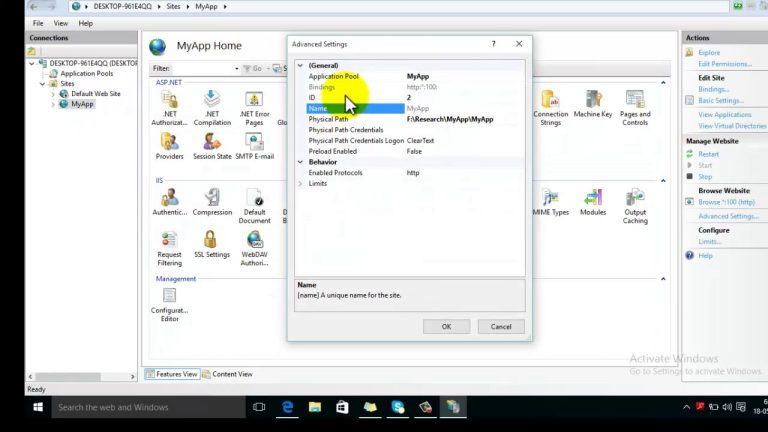Linux What is my DNS Server
Are you tired of relying on external DNS servers for your internet queries? Do you want to take control of your network’s DNS resolution and improve your internet speed and security? Look no further than setting up your own DNS server on Linux. With Linux, you have the power to customize and optimize your DNS server to meet your specific needs and preferences.
Whether you’re a small business owner looking to improve your network’s efficiency or a tech-savvy individual looking to enhance your internet experience, setting up your own DNS server on Linux is a great option. In this article, we’ll guide you through the process of discovering and setting up your Linux DNS server with ease.
Understanding DNS Servers
You may be wondering how the internet knows where to send you when you type in a website address, but have you ever thought about the complex system of servers that make it possible?
DNS servers are responsible for translating the human-readable website addresses into IP addresses, which the internet uses to direct your request to the appropriate server. Without DNS servers, the internet would be practically unusable.
DNS resolution troubleshooting is an essential skill for anyone who works with websites or internet connectivity. If your DNS server is not working correctly, it can result in slow or non-existent internet connections, which can cause significant issues for businesses and individuals alike. Some of the most common DNS server problems include incorrect configurations, outdated software, or misconfigured firewalls. With the right knowledge, you can troubleshoot these issues and get your DNS server back up and running in no time.
DNS server security measures are also crucial to ensure that your server remains protected from malicious attacks. Hackers can exploit DNS servers to redirect users to fake websites or intercept sensitive information, which can be devastating for businesses and individuals alike. To prevent these attacks, you should implement secure configurations, regular updates, and proper access controls. By taking these steps, you can ensure that your DNS server remains a reliable and secure part of your network infrastructure.
Benefits of Setting Up Your Own DNS Server
By setting up your own DNS server, you can streamline your internet connection and improve website load times, resulting in a faster and more efficient online experience. This can be particularly beneficial for businesses or households with multiple devices and users.
Some of the main benefits of setting up your own DNS server include:
- Cost savings: By using your own DNS server, you can avoid paying for third-party DNS services, which can save you money in the long run. Additionally, you can customize your DNS server to meet your specific needs, which can also help reduce costs.
- Improved network performance: With your own DNS server, you can have more control over your network traffic and reduce the risk of bottlenecks or slowdowns. This can result in faster website load times, improved streaming quality, and better overall network performance.
- Increased security and privacy: When you use a third-party DNS service, your internet activity can be tracked and monitored. By setting up your own DNS server, you can better protect your online privacy and reduce the risk of cyber attacks.
Overall, setting up your own DNS server can be a valuable investment for those looking to improve their internet connection and reduce costs. While it may require some initial setup and maintenance, the benefits can be well worth the effort. With a faster, more efficient network, you can enjoy a better online experience and more productive work or leisure time.
Choosing the Right Linux Distribution for Your DNS Server
If you’re looking to improve your network performance and security, it’s important to note that over 70% of the world’s web servers run on Linux, making it a reliable choice for setting up your own DNS server. However, with so many Linux distributions available, it can be overwhelming to choose the right one for your needs. Two popular choices for setting up a DNS server are CentOS and Ubuntu.
CentOS is a stable and reliable distribution that is known for its security features. It’s a great choice for those who prioritize stability and security over the latest features and updates. On the other hand, Ubuntu is a popular choice for those who want the latest features and updates, as well as a user-friendly interface. Both distributions can be configured to run a DNS server, but it’s important to consider which one best fits your needs.
When configuring a DNS server on cloud servers, it’s important to choose a distribution that is compatible with your cloud provider. For example, if you’re using Amazon Web Services, you may want to choose a distribution that is optimized for AWS, such as Amazon Linux. Additionally, it’s important to choose a distribution that has good documentation and community support, as this can make it easier to troubleshoot any issues that arise. By carefully considering your needs and researching the available options, you can choose the right Linux distribution for your DNS server.
Setting Up Your Own DNS Server on Linux
Installing and Configuring BIND on Linux can be daunting, but with a little guidance, you can get it up and running in no time. After installing BIND, you’ll need to configure forward and reverse zones. This involves creating zone files and modifying the BIND configuration file to point to those files. Once you’ve done this, it’s important to test your DNS server to ensure that it’s functioning properly.
Installing and Configuring BIND
Get ready to set up BIND—the powerful tool that’ll help you manage your network’s domain names and IP addresses seamlessly.
Installing BIND is a straightforward process that requires a basic understanding of the Linux command line. Once you’ve installed the package, you’ll need to configure BIND to suit your needs.
Here are the steps to install and configure BIND on your Linux server:
- Install the BIND package using your distribution’s package manager. You can do this by running the following command on your terminal:
sudo apt-get install bind9(for Debian and Ubuntu)sudo yum install bind(for CentOS and Red Hat)
- After installation, locate the BIND configuration file named
named.conf. This file is usually located in the/etc/bind/directory. - Open the
named.conffile and configure BIND to suit your needs. This involves specifying your DNS zones, setting up your DNS records, and ensuring that your DNS server is properly secured.
Troubleshooting BIND can be a daunting task, but it’s essential for maintaining a secure and reliable DNS server. Common issues with BIND include incorrect configuration, permission problems, and network connectivity issues. To troubleshoot BIND, start by reviewing your configuration files to ensure that they’re correct. You can also check your network connectivity and DNS resolution using tools like ping and nslookup.
Finally, make sure that your DNS server is properly secured by configuring firewall rules, using DNSSEC, and limiting zone transfers. With these steps, you’ll be able to set up and maintain a rock-solid DNS server using BIND.
Configuring Forward and Reverse Zones
Now that you’ve successfully installed BIND, it’s time to configure your forward and reverse zones to ensure that your network’s domain names and IP addresses are properly managed and resolved with confidence. Configuring forward zones involves creating a zone file that maps domain names to IP addresses. You can create this file using a text editor, and then add it to your BIND configuration file.
Once you’ve created the forward zone file, you can add it to the configuration file by specifying the zone’s name, the path to the zone file, and the type of zone. After adding the forward zone file, you can use the nslookup command to test whether your DNS server is correctly resolving domain names to IP addresses. Configuring reverse zones involves creating a zone file that maps IP addresses to domain names. This is known as a reverse lookup. To create a reverse zone file, you need to know the subnet of the IP address range you want to map.
You can then use a tool like the reverse DNS delegation tool to create the zone file. Once you’ve created the reverse zone file, you can add it to your BIND configuration file in the same way as the forward zone file. DNS troubleshooting can be time-consuming, but by configuring your forward and reverse zones correctly, you can reduce the likelihood of problems occurring and make it easier to diagnose and fix any issues that do arise.
Testing Your DNS Server
To ensure that your newly configured BIND DNS server is functioning correctly, you’ll need to test it using various tools and commands to verify its accuracy and reliability. One of the most reliable ways to test your DNS server is by performing a DNS lookup. This involves using a command-line tool such as ‘nslookup’ or ‘dig’ to query your DNS server for a specific domain name. By doing this, you can verify that your DNS server is able to resolve domain names correctly.
Another way to test your DNS server is by analyzing its performance. This involves monitoring the server’s response time and the number of queries it is able to handle at any given time.
To do this, you can use tools such as ‘dnstop’ or ‘dnsmeter’ to measure the performance of your DNS server under different loads and conditions. Additionally, if you encounter any issues with your DNS server, you can use various troubleshooting tools and techniques to diagnose and resolve the problem. These may include examining server logs, checking network configurations, and testing connectivity to other servers.
Managing Your DNS Server on Linux
If you’re looking to effectively manage your DNS server on a Linux system, this section has got you covered. One of the most important aspects of managing a DNS server is ensuring its security. Start by setting strong passwords for all accounts with access to the server, and consider implementing two-factor authentication as an added layer of protection. Additionally, regularly update your server’s software and keep an eye out for any potential security vulnerabilities.
Troubleshooting DNS issues is another important aspect of managing your DNS server. One common issue is DNS resolution failure, which can be caused by a variety of factors such as incorrect DNS server settings or network connectivity issues. To identify and resolve these issues, you can use tools such as nslookup or dig to perform DNS queries and analyze the results. Additionally, keeping logs of DNS requests and responses can help you identify any patterns or issues over time.
In summary, managing your DNS server on a Linux system requires a focus on security and the ability to troubleshoot DNS issues effectively. By implementing strong security measures and regularly monitoring your server, you can help prevent potential security breaches. By using tools such as nslookup or dig and maintaining logs of DNS requests and responses, you can quickly identify and resolve any DNS issues that arise.
FAQs
How do I troubleshoot DNS server issues on Linux?
To troubleshoot DNS server issues on Linux, you should start by checking the DNS cache to see if the information is being stored correctly. If not, you can clear the cache to resolve any conflicts. If the issue persists, you may want to look into DNS forwarding, which allows a DNS server to send queries to other servers if it cannot resolve them locally. This can help resolve any issues with queries not being answered or incorrectly resolved. Additionally, it can be helpful to check the configuration files for any errors or misconfigurations that may be causing issues with the DNS server.
Can I use a DNS server for local network purposes only, without connecting to the internet?
If you’re wondering if you can use a DNS server for local network purposes only, the answer is yes! Setting up a DNS server on Raspberry Pi is a popular choice for this purpose. There are several DNS server software options available for you to choose from, including BIND, dnsmasq, and Unbound. It’s important to compare these options and determine which one will work best for your specific needs. Once you’ve chosen your DNS server software, you can configure it to only serve requests from your local network and not connect to the internet. This can be a useful tool for managing your local network and improving its performance.
What are the potential security risks associated with setting up my own DNS server on Linux?
When setting up your own DNS server on Linux, it’s important to be aware of the potential security risks associated with this process. DNS server vulnerabilities are a common target for cyber attacks, as they can be used to redirect traffic and steal data. However, there are steps you can take to mitigate DNS attacks, such as implementing DNSSEC, using firewalls to restrict access to the server, and regularly updating your software to patch any known vulnerabilities. It’s also crucial to monitor your DNS server for any unusual activity, as early detection can prevent serious damage. By taking these precautions, you can ensure that your self-hosted DNS server remains secure and reliable.
How can I configure DNS server logging and monitoring on Linux?
To effectively monitor and manage your DNS server on Linux, it’s important to configure logging and monitoring. You can use tools like BIND to configure logging options, including logging queries, errors, and security events. Additionally, implementing DNS server backups is crucial to ensure that you don’t lose any important data in case of system failure or other issues. You can use tools like rsync or scp to create backups of your DNS server files and configurations.
Finally, implementing DNS server failover is also important for maintaining uptime and ensuring that your DNS queries are always resolved. This can be achieved through tools like Keepalived, which allows you to configure a redundant DNS server that can take over in case of failure. By following these steps, you can ensure that your DNS server runs smoothly and securely.
Are there any recommended best practices for maintaining and updating a Linux DNS server?
To maintain and update your Linux DNS server, there are some recommended best practices you should follow. Firstly, consider implementing DNS server automation to streamline the process of updating and maintaining your server. This can save time and reduce the risk of errors. Additionally, DNS server load balancing can help distribute traffic evenly across multiple servers, improving performance and minimizing downtime. It’s also important to regularly update your server with security patches and software updates to ensure maximum stability and security.
Finally, keep detailed records of all changes made to your server and regularly review and audit these records to ensure your server is always running smoothly. By following these best practices, you can ensure your Linux DNS server is always up-to-date and performing at its best. So there you have it – a thorough guide on discovering your Linux DNS server with ease. Setting up your own DNS server can be a game-changer in terms of internet speed and privacy, as well as offering more control over your network. It’s like having your own personal traffic controller directing your internet traffic.
Choosing the right Linux distribution and following the steps to set up and manage your own DNS server can seem daunting at first, but with the right resources and knowledge, it can be a rewarding and empowering experience. So why not take the leap and become the master of your own internet domain? With your newly acquired skills, you’ll be able to troubleshoot network issues, optimize your internet connection, and ultimately have greater control over your online experience.




